(Data correct up until the 1st March 2013)
At home this season, Liverpool average 23 shots per game according to Who Scored and rank top of all the teams in Europe’s major leagues. Manchester United ranks a lowly 22nd with 16.2 shots per game at Old Trafford; however, Ferguson’s team have collected 36 out of 39 points (92% of points available or 2.76 points per game) whereas Rodgers’ Liverpool won just 24 out of 42 points at Anfield (57% or 1.71ppg). The same trend is true away from home.
There was also another stat, read to me by Paul after the Swansea match, that claimed we had more attempts on goal (or shots) in that one match (35) than any other team in any other game, in Europe’s major leagues this season. Quite an achievement, even if we only get three points, and Laudrup did rest his defence and top scorer. My shock was compounded the next day, when completing the stats round-up I discovered Liverpool had 22 attempts in the first half and only 13 in the second. My perception was the other way round. I thought we controlled the game first half, and battered them in the second. So I thought I’d take a closer look. Watch the game again and take a screenshot at the moment each shot was taken. Then try and decide if this was the best option at the time. I was going to look at various shots, from various games but after watching the game again, I’m fairly confident this small sample, from one match, in one season, provides enough evidence to at least address some of the more persistent problems Liverpool have been having when it comes to taking the right shot, at the right time. It’s useless topping the shots on goal table, if you’re converting less than anyone else in the league.
I think we’ll discover a number of occasions when taking a shot on goal was the wrong option, just to lay my bias on the table from the beginning. I’ve been frustrated by this issue for over 18 months now. We seem to control games, have many more attempts on goal, but still continue to be wildly inconsistent in terms of results. It will also provide a little insight into the fascinating world of manual stat collection, and how the definitions can be tricky. I counted nine Clear Cut Chances, Opta counted six. That will also be added to the poll, to see if we fans think differently to the professionals.
Each shot slide will have the name of the scorer, the result of the shot (on target, off target, blocked), is it a Clear Cut Chance or not and my own answer to the simple question: should he shoot? I’ve kept it as simple as possible because there are so many different factors that go into the decision to shoot. Primarily, is it a clear instruction from the manager to shoot on sight? Next, do you see a better option? Either trying to beat a defender or pass to a team mate, in that split second? Finally, are you a selfish player? There are more, and it could be a number of factors working together at the same time. Nevertheless, I’d rather stick to one option for each slide and poll. Although I will expand on a few of them (particularly the shots that shouldn’t have been taken), the specific job of weighing up the various options each player had (with a degree of credibility), in each scenario, is one for the ex-strikers in the comments section to explore. I was a goalkeeper; I didn’t have ‘vision’ and nor was I ever clinical.
Before we look at the first slide, here are the definitions for all the different metrics that will be considered during this analysis:
From OptaSportsPro
Shot on target
Any goal attempt that:
1) Goes into the net
2) Would have gone into the net but for being stopped by the goalkeeper
3) Would have gone into the net but for being stopped by a defender who is the last man.
Shot off target
Any goal attempt where the ball is going wide of the target, misses the goal or hits the woodwork.
Blocked Shot
Any goal attempt heading roughly on target toward goal which is blocked by a defender, where there are other defenders or a goalkeeper behind the blocker.
Big Chances/Clear Cut Chances
A situation where a player should reasonably be expected to score usually in a one-on-one scenario or from very close range.
Liverpool’s shots against Swansea, at Anfield, on 18/02/13

First up our new Brazilian talent Coutinho, on his home debut, with just a minute on the clock. There are eight players between him and the goal, and that’s not including Sturridge or Vorm. Downing is free (don’t laugh) but this will also drag the Swansea players over, freeing up the three Liverpool players stood in a bunch. However, this is the problem analysing with hindsight and trying to predict what would have happened. That’s impossible. We can only speculate. Put yourself in Coutinho’s flair-filled boots for a second, and imagine being shown this image after the game. Would he agree with me? Should he pass, or turn inside? Or would he stick to his guns and say he’s happy with his decision? If Suarez was stood there instead of Downing, does that make any difference?
In the stats, Coutinho has had one shot, but it doesn’t impact on his own shooting accuracy or conversion rate, because the shot was blocked. It is also recorded in the total shots for the team.

The corner is floated in, it looks perfect, and it even looks planned from Gerrard. Downing looks set to “put his laces through the ball” before the Swansea defender tries to head it away, missing the ball, but putting poor Stewart off his stride and making the volley look like a decent return in a game of tennis-football, a lame lob, out for a goal kick. That’s my excuse anyway.
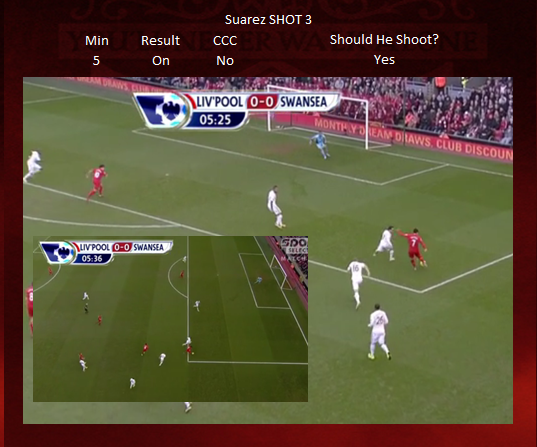
Tough one. At first glance I thought he could have squared it for Coutinho, who was free in the middle. Then watching the action from a different angle, I’m not sure it was an option. One other issue is the Swansea keeper Vorm, who appears to be anticipating a cross from Suarez. The end result was a save, as the shot was straight at the goalie.

It’s on his favoured side to curl it around the defenders closing him down, into the far corner. Or strike it and hope for a fortunate deflection. I just don’t think it’s a high percentage attempt. And surely, that’s what we should be aiming for? If Manchester United can take 7 less shots than us per match (on average), but still win every single game, bar one (and in that they scored twice) at home in the league, then they must be waiting for better opportunities. They must be creating chances or shots that have a greater chance of scoring. It can never be an exact science, and the ability of their players must be the key factor. But surely part of that ability is deciding it’s not a good time to shoot. To wait, pass it to a teammate and run in behind, or even recycle backwards and drag your marker away from the centre. It might sound harsh, it might sound ridiculous to some, but we need to stop shooting from distance when opposition players are clearly in the way. (Unless your name is Suarez, from a free kick, in the Europa League, at Anfield.)

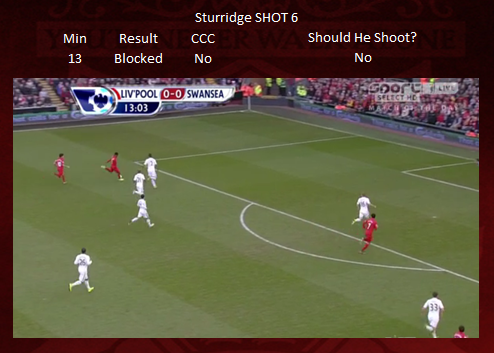
This is similar to Downing’s earlier effort. Too speculative, and don’t get me wrong they are brilliant when they fly into the net, but the chances of that happening are slim. I’d much rather Sturridge waited to take advantage of his superior finishing skills closer to the goal. Still, it was blocked and went for a corner. But was the shot worth the risk? Not for me. The ends don’t justify the means. Although, I accept there is a stronger case than for Downing’s earlier attempt; Sturridge’s superior ability, fewer men forward, it could deflect off the keeper and into Suarez’s path, it could go in.

You have to trust your wide forward, on his stronger foot, to shoot from this position. A clearer sight on goal, players waiting to pounce in the box, or latch onto a miss hit shot that’s sliced along the floor.
Shame then, he sliced it in the air, over everyone’s head (it nearly went out for a throw-in). You wouldn’t think I had a soft spot for Downing, would you? Based on this game, he didn’t have his shooting boots on. Based on this season, he’s also got a terrible shooting accuracy. My preference, Stewart, is to wait till you’re three yards out and Coutinho’s floated over a perfectly weighted cross for you to put your head on before turning away with your arm up like Alan Shearer.



Because JoeP, during the Zenit second leg, tweeted that a free kick for Suarez from this position “was basically a penalty”. He’s right. He has to shoot. Here’s a great quote from Suarez about Rodgers’ advice, and his own routine and thought processes:
As well as extra hours on the training pitch, Suarez’s ability to navigate both goalkeeper and wall has been aided by some notes from Brendan Rodgers.
“Every player has his own particular skill and technique when taking a free-kick,” said Suarez.
“But sometimes the free-kick might be from a different position, or you might have to study the ‘keeper’s technique when making a save, the position of the wall, whether they jump in the wall, if the defenders are tall and if you can get the ball up and over them.
“The manager is really good at this preparation. Before a game he shows the free-kick takers footage on dead-ball situations and that’s also important.”

No one following up, Coutinho in space to his left, Vorm stood fairly close to his line; ball drops nicely, Suarez can score from 45 yards, no-one has been able to catch him to make a run alongside or in front of him. Again, all of this is subjective, but on balance I think he’d be better off keeping control of the ball and looking for another option.

Another tricky one that I’ve got marked down as a CCC: he’s one v one, close range, and should “reasonably be expected to score”. The timing of his jump is slightly off, and he can’t get his head over the ball to direct it underneath the bar.

Just the keeper to beat, close range, has to shoot, has to score, really. But is it a CCC? It is for me.

Again, very similar to Downing’s earlier that was dragged wide past the near post. Here, Sturridge has one less player in the way to block it. Maybe a quick 1-2 with Suarez? He hits the target, but his shot is straight at Vorm.
We’ve had 14 shots before the half hour mark. Two of them were on target, two of them were CCC’s in my eyes, four of them blocked, six of them inside the box, and eight off target.
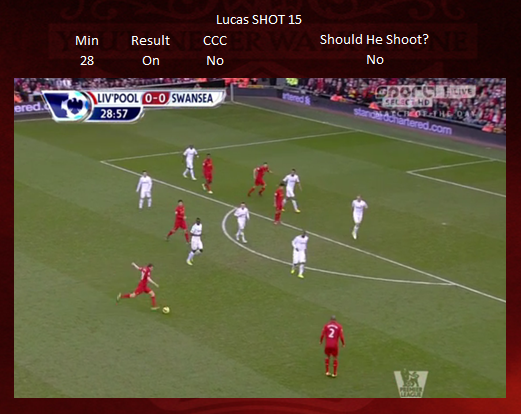
Lay it off to Johnson surely? No one is close to him. Lucas gets a decent contact but it’s straight at the keeper. He’s not exactly renowned for 25 yard thunderbolts, although this season his comprehensive shooting record reads: three shots, one on target, two blocked, 100% shooting accuracy. The one above is Lucas’s sole shot on target this campaign. He is, however, renowned for recycling the ball, reading the play, interceptions, covering attacking players, being a thoroughly decent person. Also, play to your strengths, we’ve got 3 on 2 at the back post, if he passes to Johnson and he crosses it first time.
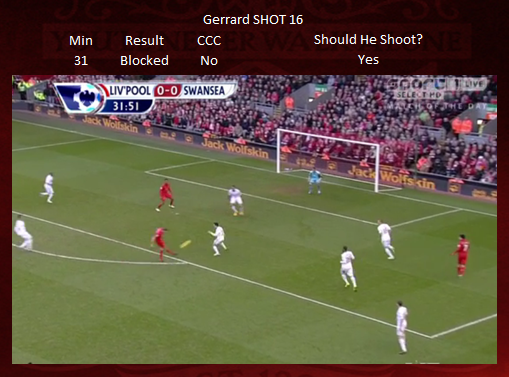



Sturridge is one on one with Vorm, from close range and should reasonably be expected to score. Although if he squares the ball along the ground, it’s a tap-in for Coutinho. I think he’s caught in two minds, kind of ‘dinks’ it over Vorm but in the direction of the Brazilian, only to under hit it and it comes to nothing.
Below is a look at the table of shots from the first half:
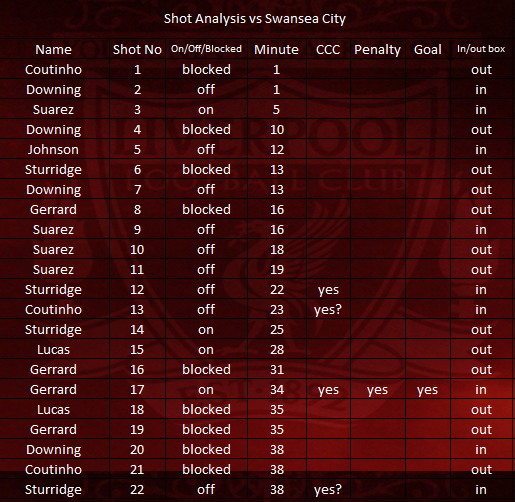
In the first half, before we scored, we’d attempted 16 shots on goal. Only three were on target, and five were blocked. Only 37.5% of shots were inside the box, before the penalty. This chimes in nicely with the theory that a teams’ shooting accuracy fluctuates depending on the result at the time, and also that a team takes more speculative efforts when they are level or chasing the game.
Half-time research:
Scoring Efficiency and Current Score by Mark Taylor (on the Opta Pro website)
…The tie appeared remarkable for many reasons. Not only had Chelsea played over half the second leg with just ten men and Messi had missed from the spot, but they had also enjoyed less than twenty percent of the possession and had been out shot by a ratio of 3:1over both legs. They had managed just 3 shots compared to Barca’s 14 in their 1-0 win at Stamford Bridge and had fared only slightly better in going down 16-7 in the return. But as Fernando Torres had so clinically demonstrated in the final minutes of the tie, having the lion’s share of the shots isn’t as important as how efficiently you finish them and Chelsea had outscored the Spanish giants by 3 goals to 2 in the column that mattered most…
Arriving at conclusions on the basis of one game or one incident is usually unwise, but it appeared that Chelsea’s 30% strike rate owed something to the simplicity of the Torres chance and Barcelona’s 7% strike rate was the result of their opponents being able to pack their backline because they had only been behind in the tie for two minutes. Before we can begin to draw wider conclusions we need to work with a larger and more detailed set of results, therefore I’m grateful to Opta for providing a season’s worth of shot statistics for Arsenal from the 2010/11 season:
Efficiency and Frequency of Arsenal’s Shots (2010/11)

Origins and Outcomes of Shots taken by Arsenal in Differing Game Situations (2010/11)

It’s worth keeping all the above in mind before moving on to the shots from the second half. When we were level, we had lots of speculative shots from outside the area. We had very few clear chances. It’s also worth remembering that I’m ignoring the context of the match when deciding if the player should shoot or not. Treating each shot as its own individual, exclusive, event. Looking at the type of shot, the estimated risk/reward scenario and whether or not there were better options open the player shooting. I’m more interested in finding the type of shot we should be avoiding.
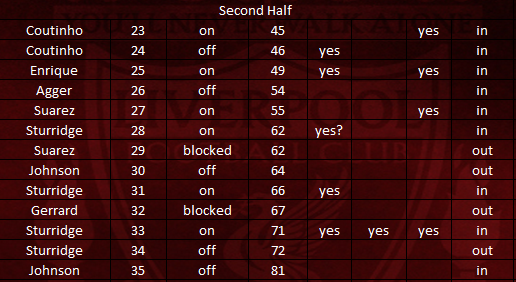
So in the second half, we’ve changed from taking 37.5% of our shots inside the area before the goal, to 66% after it. Swansea trying to score, inevitably push more players forward, leaving more gaps at the back; we pick them off and take advantage of easier chances. The difference is clear. And to an extent, it’s obvious. It’s just fascinating to ask the question: why can’t we wait for better chances when we’re level or behind or is it simply because clear chances don’t present themselves when a team is happy to sit back and let you come at them?
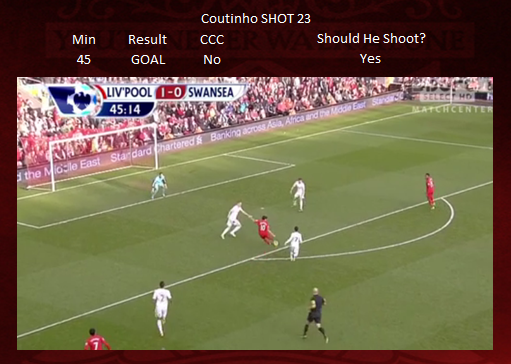
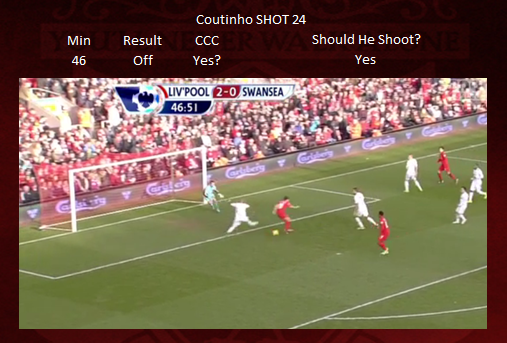
Of course he should shoot. Although, it is another tough one to make a clear decision. Initially, I thought he should, but in the more conventional manner by wrapping his foot around the ball and steering it toward goal. However, and I couldn’t get the exact frame for the shot, but it appears the ball from Suarez was just behind him. So the little flick was probably his only option (could he have laid it off for Sturridge?).



Suarez scores. We know he scores and we know it’s a wonderful finish. But look at Sturridge, waiting for a tap-in. Ignoring the result of the shot, ignore the context of the match itself, and weigh up the risk/reward ratio. I’m leaning toward yes, on the assumption most strikers are going to shoot, on instinct. Would Sturridge pass to Suarez in the same spot? I doubt it.


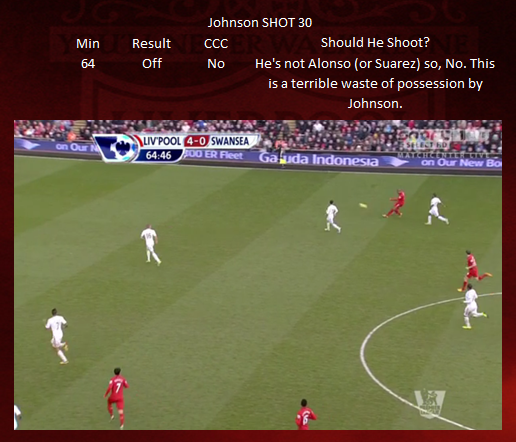





I’ve included every shot from the game, so you can make your own mind. Are you from the ‘shoot on sight’ camp or are you from the ‘Patience Dear Johnson’, shooting from 48 yards is never going to work, especially when you’ve attempted 45 shots (from a variety of positions) this season and only converted one of them (3% chance conversion) camp? That’s more shots – this season – than Mata, Cisse, Andy Carroll, Dempsey, Hazard, Lampard, Grant Holt and Shane Long. If your chance conversion rate is no better than 1 in 45, pass it. That’d be a good starting point.
Full Time Research:
Luis Suarez: Stuck in the middle, from one of my favourite blogs, ’2+2=11′ by TTT subscriber WillGM.
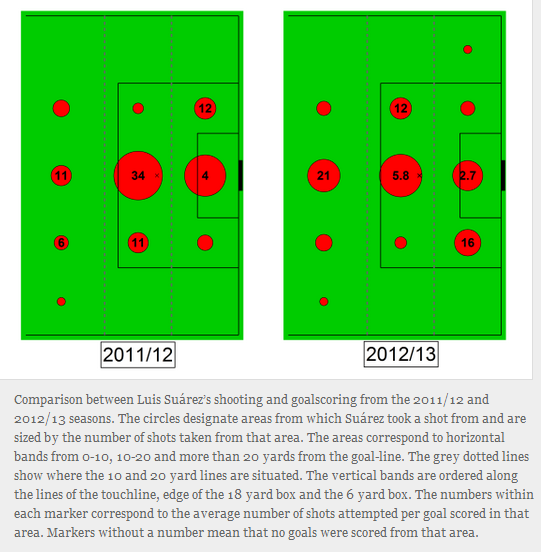
The first thing to note about the goals Suárez scores is that across both seasons, the vast majority of his goals come from relatively central areas within the penalty area or just on the edge of it. Furthermore, we can see that Suárez appears to shoot a lot from locations where he doesn’t generally score from.
There is more data available, across a sample of 15,000 Premier League shots. The football blog ‘differentgame’ put together the Shot Position Average Model (SPAM). Here’s the results, although they take a slightly different approach to Will, and reduce the number of sections down to six: penalty area central, penalty area right, penalty area left, outside the penalty area, direct free-kicks and penalties.
Penalty Conversion Rate (CR): 1 in 1.35
Direct Free-Kick (CR): 1 in 20
Penalty Area Central (CR): 1 in 6
Penalty Area Right (CR): 1 in 19
Penalty Area Left (CR): 1 in 19
Outside the Penalty Area (CR): 1 in 33
If we now match this up against Liverpool’s last four matches (Wigan away, Swansea home, WBA home and Man City away) and plot each shot we’ve attempted (using Will’s method as a rough guideline) and calculate a conversion rate, we can see a similar pattern emerging.
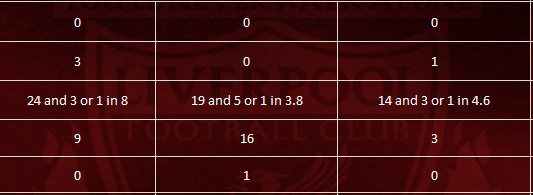
As you can see, even with such a small sample of four games, we still generally only score when we shoot from central areas. No goals whatsoever from any other area. Here’s a breakdown of the numbers.
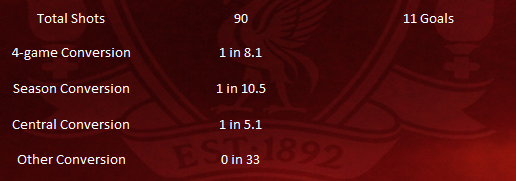
As a team, our conversion over the last four games is better than our season average. Even with the WBA performance. All the evidence points to waiting till you’re in a central area before taking a shot. I would add a caveat of making sure you have a clear (ish) sight at goal.
Post-Match Analysis:
Everyone’s favourite comparison: Liverpool vs. Manchester United

As we’ve already established, racking up the number of total shots we attempt isn’t in doubt. We’re the kings of shooting, the dominant force in the world of needless, wasted opportunities. What about Shots on Target?
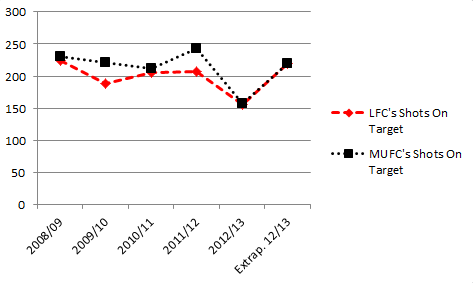
Again fairly even across the last few seasons. So what is it that accounts for the discrepancy in points totals? The next two graphs should go some way to answering that question. They’re, quite simply, more clinical than us. We have more shots, the shots on target are virtually identical, but as we move towards shooting accuracy and chance conversion, we can see the difference.
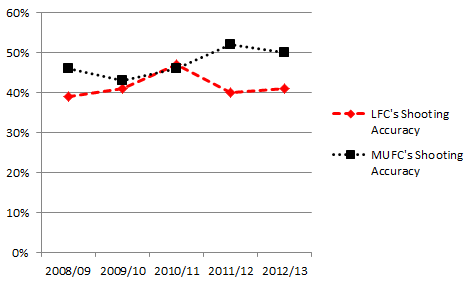
As we can see, Man Utd have had a higher shooting accuracy in every season apart from in the Hodgson/Dalglish season. Without having the detailed data to analyse where Man Utd shoot from, and if it”s markedly or even subtlety different to ours, it’s hard to know for sure if they shoot from more central areas, do they wait and pass? Do they pick the ‘right’ option more than we do? Or, are their players just better at shooting, than ours?
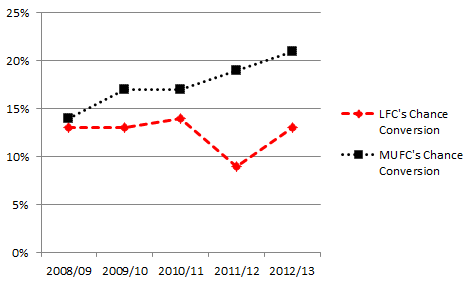
Finally, the gaping hole in our team. Converting chances. Look at the difference. It’s basically why they win the league, and we don’t even challenge. The last time we challenged, we virtually matched them. Since then, they have soared upwards whereas we have had to watch game after game of Barn Door Challenge.
As is the TTT way, this is to start the debate, not come to definitive conclusions. I hope I’ve presented the data, as well as the detail. The macro and the micro to feast over and analyse. Personally, I think we can cut out all shots from outside the area that are not central. That would be a start. Otherwise, I’m very optimistic we’re moving in the right direction. Attacking players with a variety of complimentary skills. Hopefully they can all add ‘decision-making’ to that list and realise when it’s the right time to take a shot. Not, just shoot, on sight.
Further Reading:
Premier League Goalscoring Patterns – EPL Index
They Shoot, They Score, But Should Less be More? – The Woolster
And here’s some analysis by Andrew Beasley on TTT in the subscriber only comment section (No trolls!). Make sure you check out his brilliant blog: http://basstunedtored.com/
Using the data on WhoScored, we can see how many shots per game both teams average from each part of the pitch:
|
6 yard box |
6-18 yards |
Outside Box |
| MUFC |
11% |
58% |
31% |
| Shots Per Game |
1.8 |
9.5 |
5.1 |
| LFC |
5% |
50% |
45% |
| Shots Per Game |
1.2 |
11.5 |
10.4 |
Straight away you can see that we have five shots more than them from outside the box every home match, and as they only have a 1/44 chance of being scored, that’s five shots down the drain right there (and almost half of our total shots, in fact).
You have demonstrated that we only seem to score from shooting centrally – WhoScored also have shot direction info. 62% of ours have been from the middle, and only 3 teams in the PL have a lower proportion. United on the other hand fire in 71% of their shots from the middle.
We also have the worst shooting accuracy at home in the league this season. No prizes for guessing who is top 
Finally, in case you haven’t seen it, I have plotted a graph showing our average points-per-game based on how many shots on target we have had since August 2010:
http://public.tableausoftware.com/views/LFCPPGbySoTsinceAug2010/Sheet1
8 is a bit of an anomaly, but otherwise the trend is both obvious and apparent. We need more shots on target!
Originally posted on Sports Analysis.
Link to Original Post.


















































